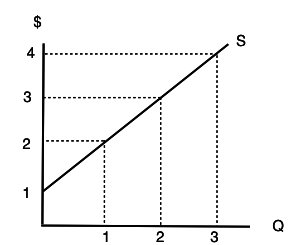11th Grade > Economics - 1
THE SUPPLY CURVE MCQs
Total Questions : 26
| Page 1 of 3 pages
Answer: Option C. -> 1
:
C
%change in price = 20−1010×100=100%
%change in quantity = 150−100100×100=50%
Elasticity=50100=0.5
:
C
%change in price = 20−1010×100=100%
%change in quantity = 150−100100×100=50%
Elasticity=50100=0.5
Answer: Option A. -> marginal cost
:
A
For a price-taking firm, willingness to accept is equal to the marginal cost. At any price less than the marginal cost, the firm will not produce an additional unit.
:
A
For a price-taking firm, willingness to accept is equal to the marginal cost. At any price less than the marginal cost, the firm will not produce an additional unit.
Answer: Option C. -> 14
:
C
Given that
p0=Rs10,p1=Rs30,q0=4,ϵs=0.5,Δp=p1−p0=Rs20
ϵs=ΔqΔp×p0q0ϵs=Δq20×104=1.25Δq=1.25×4×2010Δq=10q1=q0+Δq=14
:
C
Given that
p0=Rs10,p1=Rs30,q0=4,ϵs=0.5,Δp=p1−p0=Rs20
ϵs=ΔqΔp×p0q0ϵs=Δq20×104=1.25Δq=1.25×4×2010Δq=10q1=q0+Δq=14
Answer: Option B. -> produce an additional unit of good if the price is greater than the marginal cost
:
B
If the price is greater than the marginal cost of the next unit, the firm should continue production as there is a profit on producing the additional unit.
:
B
If the price is greater than the marginal cost of the next unit, the firm should continue production as there is a profit on producing the additional unit.
Answer: Option B. -> perfectly inelastic
:
B
The quantity of rare collectables is limited and as such, do not change with price. Hence, the supply curve would be perfectly inelastic.
:
B
The quantity of rare collectables is limited and as such, do not change with price. Hence, the supply curve would be perfectly inelastic.
Answer: Option D. -> (9,700)
:
D
The supply curve is the portion of the MC curve above the LRAC. It starts from the minimum point of the LRAC. Since the supply curve is upward sloping, for any point on the supply curve, the price will be greater than Rs 8 and quantity greater than 500 units. Only option D satisfies this condition.
:
D
The supply curve is the portion of the MC curve above the LRAC. It starts from the minimum point of the LRAC. Since the supply curve is upward sloping, for any point on the supply curve, the price will be greater than Rs 8 and quantity greater than 500 units. Only option D satisfies this condition.
Answer: Option D. -> The income of the consumers who buy the good.
:
D
Income of consumers who buy a good will only affects the demand for the good. All other factors will affect the supply.
:
D
Income of consumers who buy a good will only affects the demand for the good. All other factors will affect the supply.
Answer: Option C. -> $3
:
C
Producer surplus, Π is the area above the supply curve and below the price line.
It can be seen that at a price of $3,
Π=12×(3−1)×2=$2
:
C
Producer surplus, Π is the area above the supply curve and below the price line.
It can be seen that at a price of $3,
Π=12×(3−1)×2=$2
:
The profit level that is just enough to cover the economic costs of the firm is called normal profit.
Answer: Option B. -> LRAC = Rs 25, P = Rs 20
:
B
A firm does not supply when the market price is less than the averagecost. For option B, P < LRAC.
:
B
A firm does not supply when the market price is less than the averagecost. For option B, P < LRAC.

















